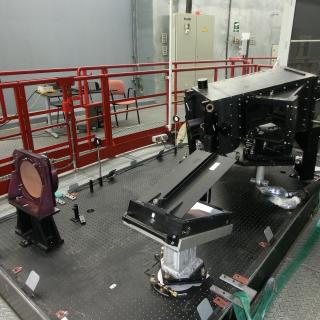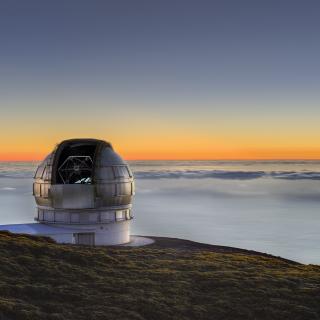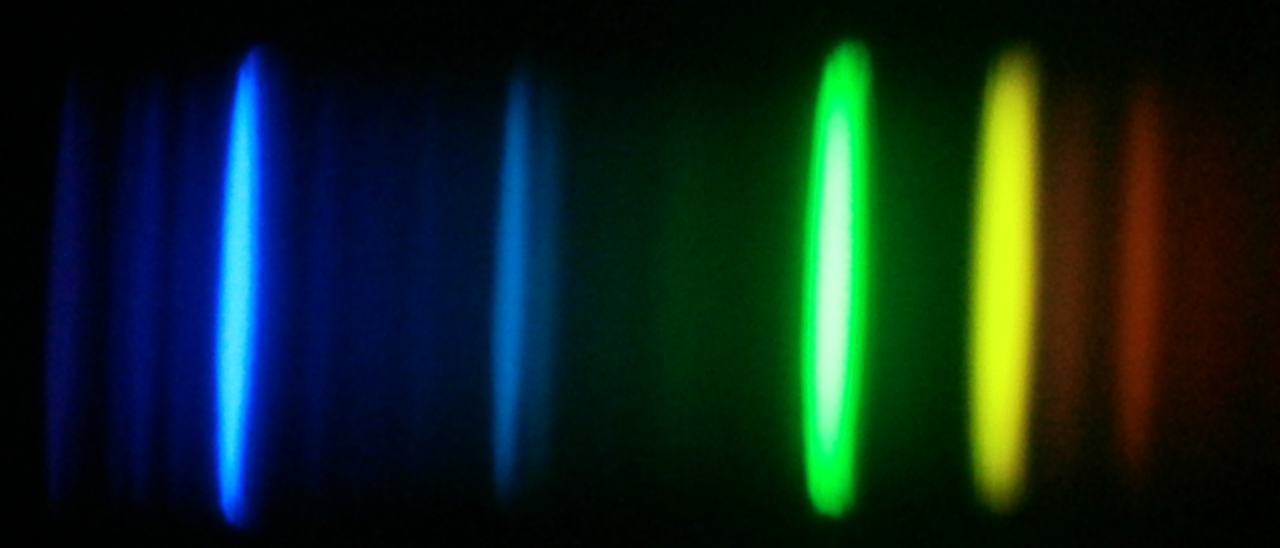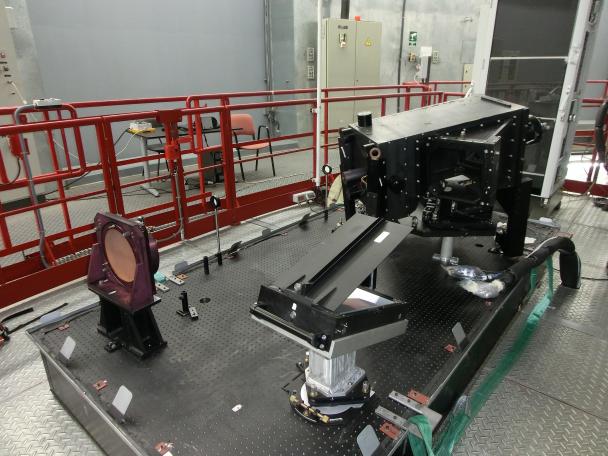Subvenciones relacionadas:
General
La espectroscopía de estrellas nos permite determinar las propiedades y composiciones químicas de las mismas. A partir de esta información para estrellas de diferente edad en la Vía Láctea es posible reconstruir la evolución química de la Galaxia, así como el origen de los elementos más pesados que el boro, forjados principalmente en los interiores estelares. También es posible estudiar la formación estelar, y la de la propia Galaxia, a través de la huella que deja el potencial Galáctico en las órbitas de las estrellas, y de las distribuciones de masa, edad y la abundancia de elementos pesados.
La obtención de espectros con alta resolución espectral, apropiados para estudios de la composición química, requiere instrumentación sofisticada y eficiente. Esto es especialmente cierto en investigaciones en las que se necesitan extensas muestras de estrellas, que exigen observar cientos, o incluso miles de fuentes de forma simultánea. El procesado y análisis de los datos debe ser automatizado para ser igualmente eficiente.
La interpretación de los espectros se basa en modelos físicos de las atmósferas de las estrellas, de donde se escapa la luz que observamos. Los ingredientes fundamentales para la construcción de estos modelos son la dinámica de fluidos, y las propiedades de los átomos, iones y moléculas, especialmente en lo que se refiere a sus interacciones con la radiación que proviene del interior estelar. Una vez que se tiene un modelo plausible, es posible calcular de forma detallada cómo se propaga la radiación a través de la atmósfera estelar, y el espectro emergente, para, de forma iterativa, compararlo con las observaciones y refinar el modelo.
Este Proyecto incluye tres diferentes frentes de investigación:
- La mejora de los modelos de atmósfera y las simulaciones de espectros estelares.
- El desarrollo de herramientas para la obtención, reducción y el análisis de observaciones espectroscópicas, y en particular para la determinación de abundancias químicas en estrellas.
- El diseño, preparación, y ejecución de estudios espectroscópicos de estrellas con el fin de entender a) los aspectos más relevantes de la física de las atmósferas estelares, b) la formación y evolución de las estrellas, c) el origen de los elementos químicos y d) la formación, estructura y evolución química de la Vía Láctea.
Miembros
Resultados
- Completar la instalación y pruebas de HORuS en GTC
- Descubrir dos nuevas estrellas con abundancias de hierro inferiores a 100.000 veces el valor solar
- Completar la clasificación de los espectros de APOGEE con K-means
- Publicar una colección completa de espectros modelo para estrellas O a M
- Identificar la huella de la difusión química en las atmósferas de estrellas del cúmulo M67
Actividad científica
Publicaciones relacionadas
-
The SEGUE Stellar Parameter Pipeline. V. Estimation of Alpha-element Abundance Ratios from Low-resolution SDSS/SEGUE Stellar Spectra
We present a method for the determination of [α/Fe] ratios from low-resolution (R = 2000) SDSS/SEGUE stellar spectra. By means of a star-by-star comparison with degraded spectra from the ELODIE spectral library and with a set of moderately high-resolution (R = 15, 000) and medium-resolution (R = 6000) spectra of SDSS/SEGUE stars, we demonstrate
Lee, Young Sun et al.Fecha de publicación:
32011 -
The merger rate of extremely low mass white dwarf binaries: links to the formation of AM CVn stars and underluminous supernovae
We study a complete, colour-selected sample of double-degenerate binary systems containing extremely low mass (ELM) ≤0.25 M&sun; white dwarfs (WDs). We show, for the first time, that Milky Way disc ELM WDs have a merger rate of approximately 4 × 10-5 yr-1 due to gravitational wave radiation. The merger end product depends on the mass ratio of the
Brown, Warren R. et al.Fecha de publicación:
22011 -
The ELM Survey. IV. 24 White Dwarf Merger Systems
We present new radial velocity and X-ray observations of extremely low mass (ELM, ~0.2 M &sun;) white dwarf (WD) candidates in the Sloan Digital Sky Survey Data Release 7 area. We identify seven new binary systems with 1-18 hr orbital periods. Five of the systems will merge due to gravitational wave radiation within 10 Gyr, bringing the total
Kilic, Mukremin et al.Fecha de publicación:
62012 -
The ELM Survey. III. A Successful Targeted Survey for Extremely Low Mass White Dwarfs
Extremely low mass (ELM) white dwarfs (WDs) with masses < 0.25 M &sun; are rare objects that result from compact binary evolution. Here, we present a targeted spectroscopic survey of ELM WD candidates selected by color. The survey is 71% complete and has uncovered 18 new ELM WDs. Of the seven ELM WDs with follow-up observations, six are short
Brown, Warren R. et al.Fecha de publicación:
12012 -
The ELM Survey. II. Twelve Binary White Dwarf Merger Systems
We describe new radial velocity and X-ray observations of extremely low-mass white dwarfs (ELM WDs, ~0.2 M sun) in the Sloan Digital Sky Survey Data Release 4 and the MMT Hypervelocity Star survey. We identify four new short period binaries, including two merger systems. These observations bring the total number of short period binary systems
Kilic, Mukremin et al.Fecha de publicación:
12011 -
The ELM Survey. I. A Complete Sample of Extremely Low-mass White Dwarfs
We analyze radial velocity observations of the 12 extremely low-mass (ELM), with
Brown, Warren R. et al.Fecha de publicación:
112010 -
The Eighth Data Release of the Sloan Digital Sky Survey: First Data from SDSS-III
The Sloan Digital Sky Survey (SDSS) started a new phase in 2008 August, with new instrumentation and new surveys focused on Galactic structure and chemical evolution, measurements of the baryon oscillation feature in the clustering of galaxies and the quasar Lyα forest, and a radial velocity search for planets around ~8000 stars. This paper
Aihara, Hiroaki et al.Fecha de publicación:
42011 -
The Apache Point Observatory Galactic Evolution Experiment: First Detection of High-velocity Milky Way Bar Stars
Commissioning observations with the Apache Point Observatory Galactic Evolution Experiment (APOGEE), part of the Sloan Digital Sky Survey III, have produced radial velocities (RVs) for ~4700 K/M-giant stars in the Milky Way (MW) bulge. These high-resolution (R ~ 22, 500), high-S/N (>100 per resolution element), near-infrared (NIR; 1.51-1.70 μm)
Nidever, David L. et al.Fecha de publicación:
82012 -
Spectroscopy from Photometry Using Sparsity: The SDSS Case Study
We explore whether medium-resolution stellar spectra can be reconstructed from photometric observations, taking advantage of the highly compressible nature of the spectra. We formulate the spectral reconstruction as a least-squares problem with a sparsity constraint. In our test case using data from the Sloan Digital Sky Survey, only three
Asensio-Ramos, A. et al.Fecha de publicación:
82010 -
SDSS-III: Massive Spectroscopic Surveys of the Distant Universe, the Milky Way, and Extra-Solar Planetary Systems
Building on the legacy of the Sloan Digital Sky Survey (SDSS-I and II), SDSS-III is a program of four spectroscopic surveys on three scientific themes: dark energy and cosmological parameters, the history and structure of the Milky Way, and the population of giant planets around other stars. In keeping with SDSS tradition, SDSS-III will provide
Eisenstein, Daniel J. et al.Fecha de publicación:
92011 -
SDSS J163030.58+423305.8: a 40-min orbital period detached white dwarf binary
We report the discovery of a new detached, double white dwarf (WD) system with an orbital period of 39.8 min. We targeted SDSS J163030.58+423305.8 (hereafter J1630) as part of our radial velocity programme to search for companions around low-mass WDs using the 6.5-m MMT. We detect peak-to-peak radial velocity variations of 576 km s-1. The mass
Kilic, Mukremin et al.Fecha de publicación:
112011 -
New ATLAS9 and MARCS Model Atmosphere Grids for the Apache Point Observatory Galactic Evolution Experiment (APOGEE)
We present a new grid of model photospheres for the SDSS-III/APOGEE survey of stellar populations of the Galaxy, calculated using the ATLAS9 and MARCS codes. New opacity distribution functions were generated to calculate ATLAS9 model photospheres. MARCS models were calculated based on opacity sampling techniques. The metallicity ([M/H]) spans from
Mészáros, Sz. et al.Fecha de publicación:
102012 -
Metallicity gradients of disc stars for a cosmologically simulated galaxy
We analyse for the first time the radial abundance gradients of the disc stars of a disc galaxy simulated with our three-dimensional, fully cosmological chemodynamical galaxy evolution code GCD+. We study how [Fe/H], [N/O], [O/Fe], [Mg/Fe] and [Si/Fe] vary with galactocentric radius. For the young stars of the disc, we found a negative slope for
Rahimi, Awat et al.Fecha de publicación:
82011 -
Lithium Abundances in nearby FGK Dwarf and Subgiant Stars: Internal Destruction, Galactic Chemical Evolution, and Exoplanets
We derive atmospheric parameters and lithium abundances for 671 stars and include our measurements in a literature compilation of 1381 dwarf and subgiant stars. First, a "lithium desert" in the effective temperature (T eff) versus lithium abundance (A Li) plane is observed such that no stars with T eff ~= 6075 K and A Li ~= 1.8 are found. We
Ramírez, I. et al.Fecha de publicación:
92012 -
Insight into the Formation of the Milky Way through Cold Halo Substructure. III. Statistical Chemical Tagging in the Smooth Halo
We find that the relative contribution of satellite galaxies accreted at high redshift to the stellar population of the Milky Way's smooth halo increases with distance, becoming observable relative to the classical smooth halo about 15 kpc from the Galactic center. In particular, we determine line-of-sight-averaged [Fe/H] and [α/Fe] in the metal
Schlaufman, Kevin C. et al.Fecha de publicación:
42012 -
Insight into the Formation of the Milky Way through Cold Halo Substructure. II. The Elemental Abundances of ECHOS
We determine the average metallicities of the elements of cold halo substructure (ECHOS) that we previously identified in the inner halo of the Milky Way within 17.5 kpc of the Sun. As a population, we find that stars kinematically associated with ECHOS are chemically distinct from the background kinematically smooth inner halo stellar population
Schlaufman, Kevin C. et al.Fecha de publicación:
62011 -
Granulation Signatures in the Spectrum of the Very Metal-poor Red Giant HD 122563
A very high resolution (R = λ/Δλ = 200, 000), high signal-to-noise ratio (S/N ~= 340) blue-green spectrum of the very metal-poor ([Fe/H] ~= -2.6) red giant star HD 122563 has been obtained by us at McDonald Observatory. We measure the asymmetries and core wavelengths of a set of unblended Fe I lines covering a wide range of line strength. Line
Ramírez, I. et al.Fecha de publicación:
122010 -
Fundamental Parameters and Chemical Composition of Arcturus
We derive a self-consistent set of atmospheric parameters and abundances of 17 elements for the red giant star Arcturus: T eff = 4286 ± 30 K, log g = 1.66 ± 0.05, and [Fe/H] = -0.52 ± 0.04. The effective temperature was determined using model atmosphere fits to the observed spectral energy distribution from the blue to the mid-infrared (0.44 to 10
Ramírez, I. et al.Fecha de publicación:
122011 -
Faint Near-ultraviolet/Far-ultraviolet Standards from Swift/UVOT, GALEX, and SDSS Photometry
At present, the precision of deep ultraviolet photometry is somewhat limited by the dearth of faint ultraviolet standard stars. In an effort to improve this situation, we present a uniform catalog of 11 new faint (u ~ 17) ultraviolet standard stars. High-precision photometry of these stars has been taken from the Sloan Digital Sky Survey and Galaxy
Siegel, Michael H. et al.Fecha de publicación:
122010 -
Circumstellar Material in Type Ia Supernovae via Sodium Absorption Features
Type Ia supernovae are key tools for measuring distances on a cosmic scale. They are generally thought to be the thermonuclear explosion of an accreting white dwarf in a close binary system. The nature of the mass donor is still uncertain. In the single-degenerate model it is a main-sequence star or an evolved star, whereas in the double-degenerate
Sternberg, A. et al.Fecha de publicación:
82011
Charlas relacionadas
No se han encontrado charlas relacionadas.Congresos relacionados
No se han encontrado congresos relacionados.Noticias

Espectrógrafo de alta resolución en operación en el Gran Telescopio Canarias (GTC) de 10m. usando componentes del espectrógrafo UES, utilizado en el Telescopio William Herschel (WHT) de 4.2 m. entre los años 1992 y 2001.

El Gobierno español concede la Acreditación como Centro de Excelencia Severo Ochoa con el fin de reconocer, premiar y promover la investigación científica de alto nivel en los centros y unidades españoles que tengan un alto nivel de excelencia en el ámbito internacional. Los objetivos específicos del Programa Severo Ochoa son: - Mejorar la






